

Pin by Carrie Key on Spiritual. Pin by Emma Salguero on Mythology. Nidhogg's Shrine: Who is Nidhogg? What we know from myth, history, and inspiration Yggdrasil, the great World Tree, has its roots in the lowest worlds - Niflheim and Helheim.
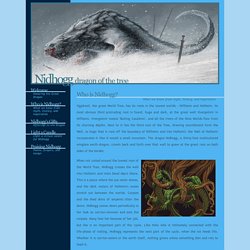
Its most obvious third protruding root is found, huge and dark, at the great well Hvergelmir in Niflheim. Hvergelmir means "Boiling Cauldron", and all the rivers of the Nine Worlds flow from its churning depths. Next to it lies the third root of the Tree, drawing nourishment form the Well, so huge that it runs off the boundary of Niflheim and into Helheim; the Wall of Helheim incorporates it like it would a small mountain. The dragon Nidhogg, a thirty-foot multicolored wingless earth-dragon, crawls back and forth over that wall to gnaw at the great root on both sides of the border. When not coiled around the lowest root of the World Tree, Nidhogg crosses the wall into Helheim and visits Dead Man's Shore. This is a lesson that modern Westerners have a hard time with.
Artwork by Katie Hofgard. Nidhogg's Shrine: Who is Nidhogg? Nidhogg - Draconika. Nidhogg is a creature from Norse mythology who chews on the tree Yggdrasill. n Norse mythology, there is an immense ash tree called Yggdrasill.
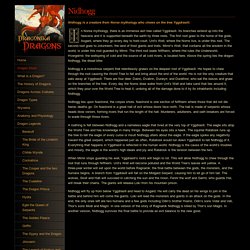
Its branches extend up into the heavens and it is supported beneath the earth by three roots. The first root goes to the home of the gods, Asgard, where they go every day to hold court. Urd’s Well, where the Norns live, is under this root. The second root goes to Jotunheim, the land of frost giants and trolls.
Nidhogg is a monstrous serpent that relentlessly gnaws on the deepest root of Yggdrasill. Nidhogg lies upon Nastrond, the corpse shore. A loathing is felt between Nidhogg and a nameless eagle that lived at the very top of Yggdrasill. When Mimir stops guarding his well, Yggdrasill’s roots will begin to rot. Nidhogg will fly up from below Yggdrasill and head to Asgard. Níðhöggr. Níðhöggr gnaws the roots of Yggdrasill in this illustration from a 17th-century Icelandic manuscript.
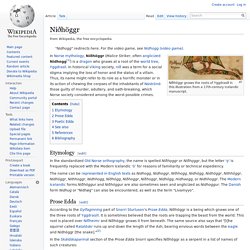
In Norse mythology, Níðhöggr (Malice Striker, often anglicized Nidhogg[1]) is a dragon who gnaws at a root of the world tree, Yggdrasil. In historical Viking society, níð was a term for a social stigma implying the loss of honor and the status of a villain. Thus, its name might refer to its role as a horrific monster or in its action of chewing the corpses of the inhabitants of Náströnd: those guilty of murder, adultery, and oath-breaking, which Norse society considered among the worst possible crimes.
Etymology[edit] In the standardized Old Norse orthography, the name is spelled Níðhǫggr or Niðhǫggr, but the letter 'ǫ' is frequently replaced with the Modern Icelandic 'ö' for reasons of familiarity or technical expediency. Prose Edda[edit] Norse Myths and Legends: Illustrations of Norse Mythology; Mythic Norse Art by Contemporary American Artist Howard David Johnson. Howard David Johnson's works have been published all over the world.

With a background in traditional media including oils, pastels & colored pencils, he embraces leading edge digital media in the creation of his depictions of fantasy, folklore, mythology, legend, religion, and heroic history. He works in and mixes a wide variety of media and is always experimenting, sometimes re-working existing pictures in various different media such as * Oil paintings * Acrylic Paintings * Prismacolor Paintings * Drawings * Chalk & Oil Pastel Paintings * Photography * Digital Artistry & Mixed Media * In David's invitation to the Florence Biennale Contemporary Art Exhibition, (a partner in the United Nations' Dialog among Nations), UN Secretary General Kofi Anon wrote him: "Artists have a special role to play in the global struggle for peace.
At their best, artists speak not only to people; they speak for them. Art is a weapon against ignorance and hatred and an agent of public awareness... Norse Myths and Legends: Illustrations of Norse Mythology; Mythic Norse Art by Contemporary American Artist Howard David Johnson. Northern Tradition Shamanism: Yggdrasil: The World Tree. In order to understand the geography of the Nine Worlds, it is crucial to start with Yggdrasil, the World Tree.
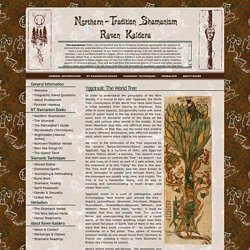
Conceptions of the World Tree have been found in tribal societies from Siberia to Polynesia; they differ in some aspects, but generally come with some kind of upper world in the top branches of the tree, some kind of ancestral world of the Dead at the roots, and various other worlds in the middle. It has been theorized that they are different trees on the same model, or that they are the same tree existing in many different dimensions, with different worlds in each, which seems more right to me somehow.
Yggdrasil the tree of life. Yggdrasil in Norse Mythology Yggdrasil: The Tree of Life In the middle of Asgard, where the gods lives, is Yggdrasil.
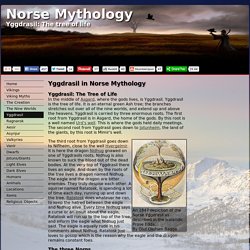
Yggdrasil is the tree of life. It is an eternal green Ash tree; the branches stretches out over all of the nine worlds, and extend up and above the heavens. Yggdrasil the tree of life. The Nine Worlds of Norse Mythology. The designation "Nine Worlds" is a well-known staple of Old Norse mythology, but what are the nine worlds exactly?
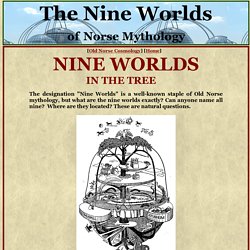
Can anyone name all nine? Where are they located? These are natural questions. In the Poetic Edda, we first learn of the tree Yggdrassil and the Nine Worlds. The clearest declaration of this is found in Völuspá 2, where the völva says: Yggdrasil, Norse world tree - Key symbols - LOTUS. Gods, elves, giants and humans The universe was born from emptiness 1, the deep abyss (Ginnungagap), with the appearance of the primeval polarity of two complementary principles: fire/ice, warm/cold, light/darkness.

Their interaction generated nine worlds equally divided into three spheres: celestial, intermediary and terrestrial. These worlds were supported by the branches of the Norse World Tree named Yggdrasil. The tree drew nutritious elements from three roots linked to three worlds covering the three preceding spheres and close to the three sources of Life, Destiny and Wisdom 2. The first creatures were born from the interaction of both principles: the giant Ymir, the primeval Androgyne father of the giants' line, and the cow Audhumla, wet nurse of the giants and ancestor of living beings and Aesir gods. World tree. From Northern Antiquities, an English translation of the Prose Edda from 1847.

Painted by Oluf Olufsen Bagge. World tree. Russian ornament. 19th century. Norse mythology[edit] THE CENTRAL SPIRITUAL SUN, THE ANTAHKARANA AND ALCHEMICAL VITRIOL. Super Computers gain speed through the number of processors connected.

Each Chakra is a processor. As we connect the chakras higher and higher along the antahkarana by removing the energy blockages between them so we gain more intelligence the higher they go, and the more chakras we connect together. THE NINE WORLDS OF THE NORSE COSMOLOGY. The purpose of this particular page is to give those who lack a good degree of familiarity with the cosmological stomping grounds of the Norse deities, and the other races of beings they regularly interact with in the myths, a crash course on the subject. I will endeavor to make this page as succinct and to the point as possible, giving only the basic information that one may require to fully understand and appreciate the complete otherworldly milieu in which the Norse deities operate within.
It should first be noted that much of the original myths as written down before and during the Age of Vikings in Europe was lost, and what survived was in certain cases rewritten by Christian monks of Scandinavian heritage who sought to preserve this literary tradition of their culture after the fall of Northern Paganism, albeit adding Christian-inspired conceits to the material. 1. THE NINE WORLDS OF THE NORSE COSMOLOGY. The Nine Worlds. Norse cosmology.